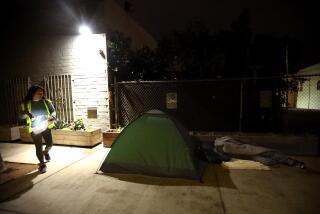Hunger on the rise in L.A. County
- Share via
A growing number of Los Angeles County’s poorest families are going hungry or can’t easily get healthy food, according to a report released Friday by the county Department of Public Health.
Close to half a million households don’t get enough to eat or struggle with limited access to nutritious food -- a 17% increase between 2002 and 2005.
“It’s ironic and sad that in this land of plenty, so many have to [make] do with so little,” Dr. Jonathan Fielding, department director, said at a news conference last week. Fielding was flanked by youngsters at Normandie Avenue Elementary, south of downtown Los Angeles, one of two schools where 125 needy children at each campus receive a backpack every other Friday filled with food for the weekend.
Although in recent years the number of poor people across California and nationwide facing unreliable food sources has remained steady, the population going hungry in L.A. County has been on the rise, particularly among Latino families, the disabled or unemployed and those with children. Public health officials have largely attributed the jump to the number of low-wage workers living in a region with a high cost of living.
Normandie fifth-grader Daniel Tate is happy to tote his bag full of rice, apple juice, canned beef stew and grocery vouchers home to his single mother and six brothers and sisters.
“It helps my mom, because when she gets off work, she has to go buy food,” he said.
The year-old backpack program, which the Los Angeles Regional Foodbank helps coordinate, is expected to expand to seven schools by next year.
And yet the same families with little or no access to nourishing meals -- who often live in areas where fast food is one of the few available dining options -- are more likely to be obese, according to the county report. Los Angeles city officials later this year will consider imposing a moratorium on new fast-food restaurants in South L.A.
As more families need help putting balanced meals on the table, the food bank, which supplies shelters, pantries and soup kitchens with food, has seen federal donations of surplus food drop from 24 million pounds in 2002 to 15 million last year.
“Demand is increasing,” said Michael Flood, president of the Los Angeles Regional Foodbank. “This is a huge hit for us.”
Friday’s report was based on results of the 2002-03 and 2005 county health surveys. The 2005 random telephone survey solicited information from 8,600 adults and 6,000 children across the county.
--
More to Read
Sign up for Essential California
The most important California stories and recommendations in your inbox every morning.
You may occasionally receive promotional content from the Los Angeles Times.










